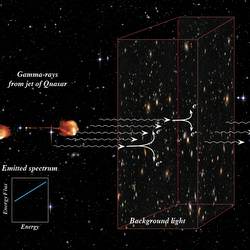
Effects of the extragalactic background light on the gamma emission by a quasar before reaching Earth. Image credit: HESS Collaboration. Click to enlarge
When astronomers look into the sky, they see bright objects, but also a diffuse glow coming from objects across the Universe in many different wavelengths. This glow could serve like a fossil record, to help astronomers untangle the different stages the Universe went through from the beginning, to the current day. Research teams are using very high energy gamma rays, generated in the most violent objects in the Universe – quasars – as a probe to understand this background light.
The light emitted from all objects in the Universe during its entire history – stars, galaxies, quasars etc. forms a diffuse sea of photons that permeates intergalactic space, referred to as “diffuse extragalactic background light” (EBL). Scientists have long tried to measure this fossil record of the luminous activity in the Universe in their quest to decipher the history and evolution of the Cosmos, but its direct determination from the diffuse glow of the night sky is very difficult and uncertain.
Very high energy (VHE) gamma-rays, some 100,000,000,000 times more energetic than normal light, offer an alternative way to probe this background light, and UK researchers from Durham University in collaboration with international partners used the High Energy Stereoscopic System (HESS) gamma-ray telescopes in the Khomas Highlands of Namibia to observe several quasars (the most luminous VHE gamma-ray sources known) with this goal in mind. The results, to be published in the April 20 issue of Nature, turned out to be rather striking.
Gamma-rays, which are produced in the most violent objects in the Universe, are absorbed in their journey from distant objects to Earth if they happen to hit a photon of “normal” background light. This fog of light in which the Universe is bathed is a fossil record of all the light emitted in the Universe over its lifetime, from the glare of the first stars and galaxies up to the present time. So, using the distant quasars as a probe and studying the effect of the fossil light on the energy distribution of the initial gamma-rays, astrophysicists used HESS to derive a limit on the maximum amount of this ‘extragalactic background light’, which is remarkably lower than what previous estimates had suggested.
This result, published in the April 20 issue of Nature, has important consequences for our understanding of galaxy formation and evolution, and expands the horizon of the gamma-ray Universe which is clearly more transparent to gamma-rays than previously believed
Commenting in the findings, Dr Lowry McComb of Durham University, said, “HESS has in the last few years achieved a number of important discoveries concerning high-energy gamma-ray sources in our own Galaxy and has revolutionized high-energy gamma-ray astronomy. These new HESS results illustrate the power of the instrument for extragalactic astronomy and cosmology. The discovery of lower levels of intergalactic starlight has the interesting side effect that the Universe becomes more transparent to gamma rays and that the telescopes can look deeper into the cosmos, increasing their reach for further discoveries!”
Original Source: PPARC News Release

Ok, what do you mean by gamma rays hitting background light? isn’t the light not supposed to interact with itself?